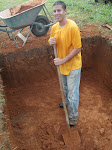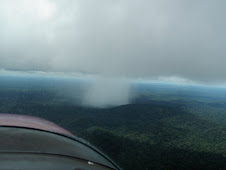Often, it happens in life that you experience one of those days in which the events that transpire seem to sum-up all that you’ve been doing. The experience is a kind of snapshot displaying a little bit of everything. Our trip to the goon (planting ground) was one of those days. One Saturday, Ba’Jepin invited us to go with him and his family to the goon (it is actually pronounced goan and yeah it was pretty funny when I first saw it spelled as well). We grabbed our gear, the equipment we bring everywhere we go, (machete, sunscreen, food, water, first aid kit, poncho etc.) took a ride up the river in the boat to a location where only Ba’Jepin himself could’ve known. There was a trail that began right at the bank. We tethered the boat to a tree, hopped out and began to hike. The path led us to the heart of the bush with all the sights and smells we have become so well acquainted with: namely the sweet floral scents of with the occasional peculiar odor signaling the presence of a snake.
We reached the goon after close to a mile of hiking. The typical Aukaan goon is a sizable acreage located away from the village where rice, corn, cassava, melons and other vegetables are grown. This food is primarily grown for each family’s consumption. The goon is farmed by slash and burn tactics and the land’s fertility is sufficient for only one season. As a result the location changes each year. A new tract of land is cleared and trees burned during the dry season and the seeds are sown to be harvested months later. The goon is far from the symmetrical, uniform American farm you see with evenly ploughed rows and spacing. The goon is littered with charred trees too large to burn and various plants and grass as tall as a man. Stalks of rice are growing in between all this. From the time we began work, Sonya, Ba’Jepin’s wife went into the field and picked stalks of rice by hand in the blazing sun with only a knife and a sack for the entire afternoon. We did some of the picking ourselves and learned how harvesting rice in this fashion is an extremely tedious and time-consuming process. We’ve participated as well as witnessed the complete process from harvesting rice to cooking it ourselves (there are a few more steps in between including pounding the rice in a giant mortar and pestle to remove the husk before sifting). We’ll never look at rice the same.
But our primary purpose was to help Ba’Jepin build a Masanga. The masanga is a thatched roof hut, a little house on the planting ground. The structure is made of wood and and palm branches; there exists not a single piece of synthetic, manmade equipment. We learned vicariously as Ba’Jepin demonstrated how to arrange and fasten the branches. For rope we used a kind of strong vine called Camina. It was strong and flexible and he told us he had looked deep in the jungle to find. As we were close to finished, much to our dismay we ran out of camina. How were we going to finish the Masanga? Not a second after he realized our means of tying was gone he told us to come with him to the edge of goon where the jungle began. Not ten meters in he had us cut down a certain plant, peel back the stem into thin strips and had us fasten them together to function as rope. It worked surprisingly well. We were able to finish the job. Taylor and I looked at each other in amazement. As we would soon find out, it would not be the last time. The roof was soon finished and was a quality piece of work: fully waterproof and would last at least two years.
The rope improvisation was an impressive feat but the highlight of the day occurred when we ventured back into the bush and began to hack down a number of medium-sized trees with trunks soft enough to felled with our machetes. The Palm-like leaves were saved for the masanga roof and Ba’Jepin’s sons mentioned to us something in Aukaan about the tree being edible. We were sure we hadn’t heard correctly. After all, we’ve only been learning the language for three months now. They insisted that this in fact was what they called Gruntu udu “vegetable wood”. They peeled back the bark to reveal a white soft core they proceeded to chew. We were skeptical to say the least, but after having already dined on Aligator, chickens feet, and Armadillo we thought we’d give it a shot. And so we ate it. It was bland but the taste was agreeable. Now we know one edible plant we could survive on if needed. It anything else, we can say, “We ate trees in Suriname”. The whole day was filled with demonstrations of ingenuity by using what the land provided. We weren’t witnessing a session on jungle survival. This was a normal family whose means of subsistence involved doing “survival” type things. The trip to the goon was an awesome learning experience, not because we ate gruntu udu or made twine out of leaves but because we were privileged to be part of a weekend family outing Suriname-style. We had the same feeling you get when you go out with your family on a recreational outing in the states. Ba’Jepin and the kids laughed at inside jokes, the boys enjoyed hacking-up trees with the machete and the Sonya and Agwena cooked. For many Aukaaners trips to the goon are the fun weekend activity everyone looks forward to. We couldn’t have asked for a better way to spend a Saturday.
Sunday, April 26, 2009
Subscribe to:
Post Comments (Atom)





1 comment:
Someone from Hong Kong told me they grew up praying at the dinner table, "God is good, God is nice, thank you God for all this rice!"
It's a joy being able to put the pictures with the stories . You're right that Caiman does look delicious in your fb pic. I can't fathom eating an kapasi.
mercy, peace, and love be yall's in abundance!
Post a Comment